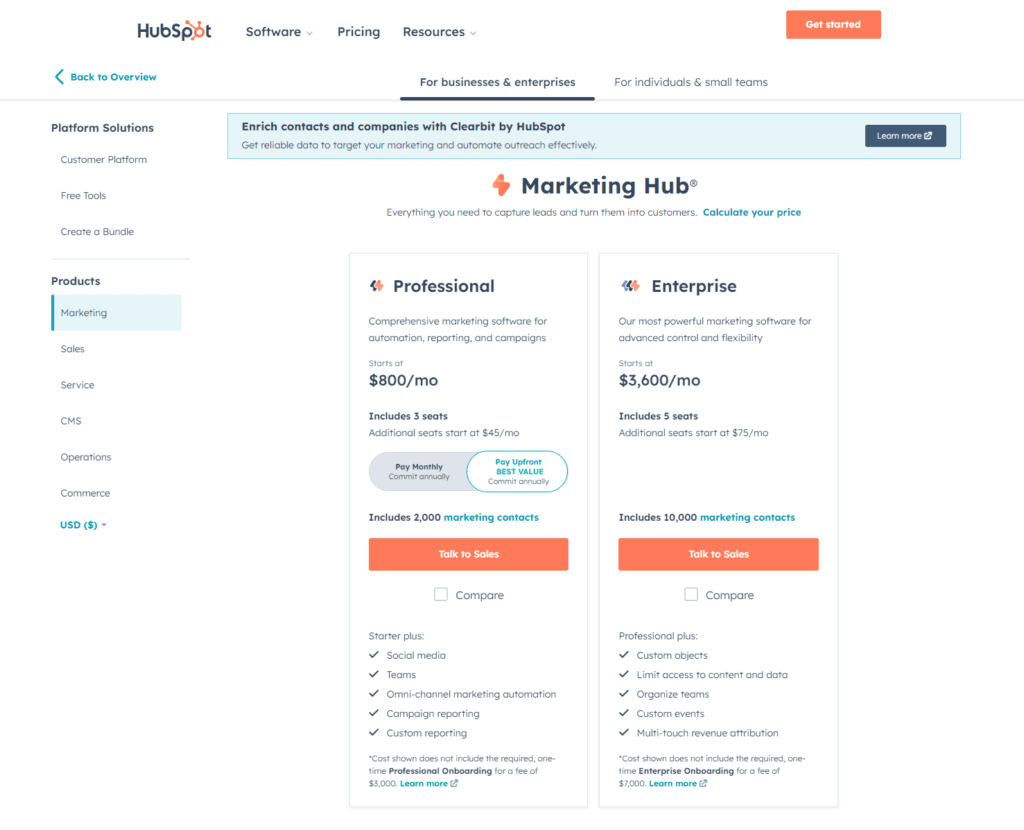Choosing between HubSpot Marketing Analytics and Mixpanel for your business can feel like deciding between a Swiss Army knife and a laser-focused scalpel. Both are invaluable tools in their own right, but their effectiveness depends greatly on the task at hand. As we dive into the bustling world of CRM tools, two giants stand out for their unique strengths and approaches: HubSpot, with its all-encompassing toolkit designed to nurture customer relationships and drive growth, and Mixpanel, renowned for its precision in user behavior analytics and product improvement insights. Let’s start by comparing their data insights and analytics capabilities to see which might be the best fit for your business.
| HubSpot Marketing Analytics | Mixpanel |
|---|---|
 |  |
| G2 Score -4.4 out of 5 | G2 Score -4.6 out of 5 |
| TrustRadius Score -8.5 out of 10 | TrustRadius Score -8.3 out of 10 |
User Interface and User Experience: Steering the Ship with Ease
Imagine navigating a ship through a dense fog. The design of your instruments and the layout of your controls can either make this task feel intuitive, allowing you to focus on the journey ahead, or cumbersome, requiring your constant attention to prevent getting lost. Similarly, the UI and UX of your CRM or analytics tool play a pivotal role in how effectively your team can navigate the complexities of digital marketing.
HubSpot Marketing Analytics: The Intuitive Compass
HubSpot is often lauded for its clean, intuitive interface that simplifies the vast ocean of data and marketing tools into an easily navigable dashboard. The platform is designed with the user in mind, ensuring that valuable data and insights are never more than a few clicks away. This approach extends across the entire HubSpot suite, offering a consistent, user-friendly experience whether you’re diving into analytics, managing customer relationships, or automating marketing campaigns.
The strength of HubSpot’s UX lies in its ability to cater to users of all levels — from digital marketing novices to seasoned strategists. The platform achieves this through a combination of intuitive design, personalized dashboards, and in-context tips and guides. For businesses looking for a CRM and marketing analytics tool that can be quickly adopted across teams, HubSpot offers an environment that encourages exploration and learning without overwhelming its users.
Mixpanel: The Detailed Map
Mixpanel, on the other hand, offers a UI and UX that are meticulously crafted for the analysis of user behavior and product performance. The platform presents a more focused environment, designed to deliver complex data insights in a digestible format. While Mixpanel’s interface might present a steeper learning curve compared to HubSpot, it’s precisely this detail-oriented design that allows businesses to dive deep into analytics.
Mixpanel’s dashboard and reporting tools are highly customizable, enabling users to tailor their analytics views to match their specific needs and preferences. This level of customization ensures that teams can quickly access the insights most relevant to their goals, from user engagement metrics to conversion paths. For businesses with a strong emphasis on leveraging detailed analytics to guide product development and marketing strategies, Mixpanel’s UX is a powerful tool that offers both depth and precision.
Pricing
HubSpot Marketing Analytics

Mixpanel

Data Insights and Analytics: Navigating the Numbers
In today’s digital age, data is more than just numbers—it’s the lifeblood of your business strategy, offering insights that can catapult your growth or highlight areas in need of refinement. Both HubSpot Marketing Analytics and Mixpanel wield these numbers, but they do so with different tools and visions in mind.
HubSpot Marketing Analytics: The 360-Degree View
Imagine having a bird’s-eye view of your entire marketing landscape—every email, social media interaction, website visit, and customer conversation captured and analyzed to offer a comprehensive understanding of your marketing efforts. That’s the realm of HubSpot Marketing Analytics. It’s designed to be the central nervous system of your marketing efforts, integrating data from various channels into a cohesive dashboard that offers actionable insights and performance metrics.
HubSpot excels in tracking customer journeys from the first point of contact through to conversion and beyond, offering a suite of tools that help you understand how each marketing effort contributes to your bottom line. Whether you’re dissecting email campaign performance, monitoring website traffic, or analyzing social media engagement, HubSpot provides a detailed, yet digestible, overview of your marketing health.
The platform shines in its ability to not only collect and display data but to also offer recommendations and automation tools based on that data, effectively closing the loop between analytics and action. This makes HubSpot an invaluable partner for businesses looking to not just understand their data, but to actively improve their marketing strategies in real-time.
Mixpanel: The Microscope on User Behavior
While HubSpot offers a broad view, Mixpanel zooms in, offering a microscope to examine the intricacies of user behavior and product interaction. It’s the tool you turn to when you want to understand not just that something happened on your website or app, but precisely how and why it happened. Mixpanel’s event-based tracking model allows for granular analysis of user actions, giving product teams powerful insights into how individuals interact with their digital offerings.
Mixpanel differentiates itself with its focus on product analytics, offering detailed funnels, retention analysis, and user segmentation. This level of detail is invaluable for businesses focused on optimizing product use and engagement, as it allows for deep dives into the data to understand user paths, identify drop-off points, and test changes with A/B testing tools.
For teams dedicated to refining and improving a digital product or service, Mixpanel offers the analytical precision needed to make informed decisions and drive product strategy. Its ability to track specific user actions and correlate them with broader trends makes it a powerful tool for anyone looking to enhance product engagement and user satisfaction.
Integration Capabilities: Weaving the Digital Marketing Tapestry
Imagine your marketing tools and platforms as threads in a vast tapestry. The more seamlessly these threads are woven together, the more detailed and vibrant the picture becomes. Here’s how HubSpot Marketing Analytics and Mixpanel fare in the task of integrating with other digital marketing tools and services, essentially determining how well they can bring together the various threads of your marketing strategy.
HubSpot Marketing Analytics: The Master Weaver
HubSpot is akin to a master weaver when it comes to integrating with other software. Its platform boasts an expansive library of integrations, connecting with over 500 other tools that businesses commonly use across various functions — from email marketing and social media platforms to customer service tools and content management systems. This extensive network includes popular names like Salesforce, WordPress, Slack, and Shopify, among others.
The beauty of HubSpot’s integration capabilities lies in its native connectors, designed to ensure that data flows seamlessly between HubSpot and these third-party tools. This means you can track your customer’s journey across different touchpoints, manage your content strategy, analyze social media performance, and even streamline customer support efforts, all within HubSpot’s ecosystem. For businesses looking for a CRM tool that can serve as a central hub for their marketing efforts, HubSpot’s broad and deep integration capabilities make it a compelling choice.
Mixpanel: Precision in Connectivity
Mixpanel, with its focused approach on product and user analytics, offers a more curated set of integrations, specifically chosen to enhance its core functionality. While it may not match HubSpot’s volume, Mixpanel integrates seamlessly with key tools that support data analysis, product development, and marketing automation. These integrations include platforms like Segment, for gathering customer data from various sources, and marketing automation tools like Marketo and email platforms such as Mailchimp.
Mixpanel’s integrations are designed to enrich its analytics capabilities, allowing businesses to import and export data to and from Mixpanel for deeper analysis and action. For instance, you can use Mixpanel’s insights to segment your audience and then execute targeted campaigns through your marketing automation tool. This level of integration is invaluable for businesses focused on leveraging detailed analytics to drive product decisions and marketing strategies.

Related: Check out our free SEO suite

Customer Support and Educational Resources: Navigating Through Challenges
Imagine setting sail across the open ocean. The journey is exhilarating, filled with opportunities for discovery and growth. However, it’s also unpredictable, with potential storms and navigational challenges. In such moments, having a knowledgeable and responsive support crew, along with a detailed map and guidebook, can be invaluable. Here’s how HubSpot Marketing Analytics and Mixpanel stack up in providing this support to their users.
HubSpot Marketing Analytics: The Guiding Star
HubSpot is renowned not just for its robust platform but also for its comprehensive support and educational ecosystem. The platform offers multiple layers of customer support, including 24/7 access via chat, email, and phone, ensuring that help is readily available whenever needed. This is complemented by an extensive knowledge base filled with articles, guides, and FAQs to help users find quick answers to their questions.
Beyond immediate support, HubSpot shines with its educational offerings. HubSpot Academy is a treasure trove of learning, providing free courses, certifications, and training on a wide range of topics related to marketing, sales, customer service, and content management. These resources are designed not just to help users maximize the platform’s capabilities but also to enhance their overall marketing expertise.
Furthermore, HubSpot’s community forum serves as a vibrant space for users to share insights, ask questions, and learn from each other’s experiences. This combination of direct support, self-help resources, and community engagement makes HubSpot a guiding star for businesses navigating the complexities of digital marketing.
Mixpanel: The Specialist Navigator
Mixpanel, with its focus on analytics, approaches customer support and education with a lens finely tuned to the needs of data-driven teams. The platform offers dedicated support through email and an in-depth knowledge base that covers technical documentation, best practices, and step-by-step guides. While Mixpanel’s direct support might not be as immediately accessible as HubSpot’s 24/7 offerings, it is highly specialized, ensuring that users receive expert guidance on analytics-related queries.
Education-wise, Mixpanel provides a variety of resources aimed at helping users understand and leverage analytics more effectively. This includes webinars, tutorials, and a blog that delves into analytics strategies, product updates, and case studies. Although it might not offer a formal educational program like HubSpot Academy, Mixpanel’s resources are rich with insights specific to analytics and product optimization, making it a valuable navigator for businesses focused on these areas.
Conclusion
As we conclude our deep dive into the comparison between HubSpot Marketing Analytics and Mixpanel, it’s evident that both platforms offer unique strengths tailored to different business needs and objectives. Through our exploration of key areas — data insights and analytics, integration capabilities, pricing models, customer support and educational resources, and the user interface and user experience — we’ve uncovered the distinctive landscapes each tool navigates best.
READ NEXT:
- Escape the Debt Trap: SEO Solutions for Debt Management
- Company Formation: DIY vs. Hiring a Professional Service
- The Power of Professional Company Formation Services: A Case Study Analysis
- 15 Types of Advertising Propaganda Used by Advertisers
- 11 Marketing Analytics Tools to Elevate Your Data-Driven Strategies
- 29+ Digital Analytics Software to Skyrocket Your Digital ROI
- Bitrix24 vs Vtiger: The Best CRM Tool for You






















Comments are closed.